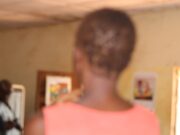At what age should you perform a self-breast examination? When should you examine your breasts? How do you examine your breasts properly? What exactly should you be looking out for when doing the examination? Do you know how to identify unusual signs of the breast at the early stages?
Well, today I share information by Prof. Ronald Wasike, Consultant Breast Surgeon, Aga Khan University Hospital on the issue of breast self-examination, which provides answers to the above questions. Read it and share with your friends.
At what age should women perform Self-Breast Examination and why?
If you are a woman aged 20 years and above, it is important to take just a few minutes each month to examine your breast and ensure they are healthy. Regular examination enables women to identify any alarming signs changes in their breast early (more importantly is to have self-breast awareness) and if treatment is needed, it can be started as soon as possible to ensure better treatment outcomes. In most cases the problem may be a cyst or a small growth that can be dealt with easily. If it is cancer, then early detection gives a greater chance of effective treatment and cure.
When should I examine my breasts?
You need to examine your breasts at the same time each month as they will change in shape and feel different during your monthly cycle. One to two weeks following your monthly period is the best time. If you have reached menopause, the examination could be done on the first day of each calendar month.
During the first examination, you should note the normal size and the shape of each breast, the feel of the breasts (either one being larger or higher than the other is normal) and the position of the nipples. Knowing your body well makes it easier to spot any changes.
How do I examine my breasts properly?
Undress to the waist and stand relaxed in front of a well-lit mirror with your arms by your side. Turn from side to side for a complete view of the breasts and make sure that the part of the breast going towards the armpit is normal. Take your time.
To ensure you examine your breasts properly, you need to know where the boundaries of the breasts are. The boundaries are clearly recognisable below the nipple and on the inner side of the breast but the upper and outer parts fade away into the skin. Imagine your breast shaped like a water droplet with the top stretching towards the armpit (and sometimes extending into it).
Check for any changes in shape or size, as well as discolouration, very prominent veins or whether either nipple is turned in.
With your hands on your hips, look at your breasts, again turn from side to side and look underneath; push your hands inwards towards the hips until you feel your chest muscles tighten. Look again at your breasts while you keep pressing and note any puckering (creases) of the skin or retraction of the nipples.
Place your hands lightly on top of your head and again look at your breasts carefully. This position emphasises any differences in size or shape of the breasts. Now concentrate on the nipples and look for any excessive upward or outward change of the either nipples.
Stretch your arms high above your head; again, this emphasises any differences between the two breasts. Finally, look down at your breasts and squeeze each nipple gently to check for any bleeding or discharge, which is unusual for you. Make sure that the top part of your arms is not swollen.
How do I feel my breasts (palpation)?
Many women who have not reached menopause have rather lumpy breasts just before their periods and for some women, this may persist for the whole month. In such cases, it becomes easier to detect any unusual lumps during examination.
Lie down comfortably on a flat surface with your head on a pillow and slightly raise the side that you are examining. Use your right hand to examine your left breast and vice versa. Examine one breast at a time.
Also Read: Elizabeth Muema: Crocheting for Cancer is my Ministry
With your left shoulder raised, feel your left breast using the three middle fingers of your right hand. Keep your fingers flat and close together; start from the collar bone above your breast, pressing the breast gently but firmly towards the body, tracing a continual spiral.
Move your fingers in small circles, working right around the outside of the breast.
Continue to work systematically over the whole surface of the breast, checking for any lumps.
Now place your arm comfortably above your head with elbow bent and carefully repeat the examination of the whole breast, paying attention to the outer part which can now be felt with more certainty.
You may find a ridge of half-moon shaped firm tissue under your breast, this is normal as this tissue helps to support the breast.
Finally, examine the tail of the left breast ensuring that you go right up into the hollow of the armpit.
Now repeat the same for the right breast. If you think you have found something wrong, or if there is a noticeable change since the last examination, consult your doctor without delay, it does not matter how uncertain you are. Take note of the change since the last examination or the location of the just identified lump, but leave it alone until you see the doctor.
Most lumps are not cancerous. If the lump is cancerous, it can be treated early enough, sometimes even without requiring mastectomy but breast conservation surgery.
What should I look out for during examination/Warning signs?
- Unusual difference in size or shape of the breast
- Alteration in the position of either nipple
- Dimpling of the skin surface
- Unusual rash on the breast or nipple
- Unusual discharge from the nipple
- Unusual discrete lump or nodule in any part of either
You May Also Like to Read:
“A Walk Through my Cancer Journey” -Wanjiru Githuka

Facts:
Breast cancer constitutes 20 per cent of all women cancers in Kenya with 4,465 new cases and 1,969 deaths being reported every year according to Globocan statistics 2012-2014.
Breast cancer affects more women with less than 10 per cent affecting men. However, these numbers can be reduced with increased awareness on the disease including simple interventions like performing self-breast examinations, to identify unusual signs of the breast at the early stages and seek treatment in good time to ensure better outcomes.
I hope the information above helps. Share it with a friend 🙂
Mummy Tales is an organization dedicated to empowering its readers on different aspects of womanhood and motherhood. Mummy Tales is the top Women & Girl Empowerment blog in Kenya (BAKE 2017 awards) and 2016 top Women & Girl Empowerment blog (African Blogger Awards). Read more motherhood experiences of Kenyan moms here. Follow Mummy Tales on: FACEBOOK l YOU TUBE l INSTAGRAM l TWITTER




































